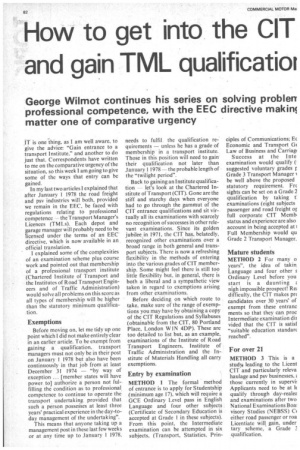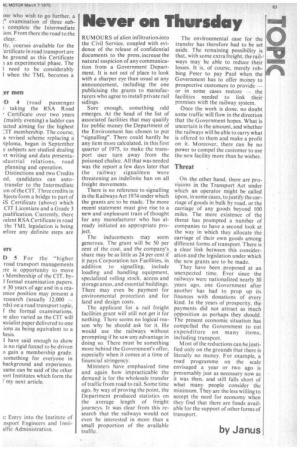How to get into the CIT and gain TML qualificatior
Page 84

Page 85

If you've noticed an error in this article please click here to report it so we can fix it.
George Wilmot continues his series on solving problen professional competence, with the EEC directive makini matter one of comparative urgency
IT is one -thing, as I am well aware, to give the advice: "Gain entrance to a transport Institute," and another to do just that. Correspondents have written to me on the comparative urgency of the situation, so this week 1 am going to give some of the ways that entry can be gained.
In my last two articles! explained that after January 1 1978 the road freight and psv industries will both, provided we remain in the EEC, be faced with regulations relating to professional competence -the Transport Manager's Licences (TM Ls). Each depot and .garage manager will probably need to be licensed under the terms of an EEC directive, which is now available in an official translation.
I explained some of the complexities of an examination scheme plus course work and pointed out that membership of a professional transport 'institute (Chartered Institute of Transport and the Institutes of Road Transport Engineers and of Traffic Administration) would solve all problems on this score as all types of membership will be higher than the statutory minimum qualification.
Exemptions
Before moving on, let me tidy up one point which I did not make entirely clear in an earlier article. To be exempt from gaining a qualification, transport managers must not only be in their post on January I 1978 but also have been continuously in that job from at least December 31 1974 — "by way of exception ... [member states will have power to] authorize a person not fulfilling the condition as to professional competence to continue to operate the transport undertaking provided that such a person possegSes at least three years' practical experience in the day-today management of the undertaking".
This means that anyone taking up a management post in these last few weeks or at any time up to January 1 1978, needs to fulfil the qualification requirements — unless he has a grade of membership in a transport institute. Those in this position will need to gain their qualification not later than January 1 1978 — the probable length of• the "twilight period".
Back to gaining an I nstitute qualification — let's look at the Chartered Institute of Transport (CIT). Gone are the stiff and starchy days when everyone had to go through the gammut of the CIT entrance qualifications and sit virtually all its examinations with scarcely no recognition of successes in other relevant examinations. Since its golden jubilee. in 1971, the CIT has, belatedly, recognized other examinations over a broad range in both general and transport subjects. There is now a refreshing flexibility in the methods of entering into the various grades of CIT membership. Some might feel there is still too little flexibility but, in general, there is both a liberal and a sympathetic view taken in regard to exemptions arising from other examinations.
Before deciding on which route to take, make sure of the range of exemptions you may have by obtaining a copy of the CIT Regulations and Syllabuses (obtainable from the CIT, 80 Portland Place, London WIN 4DP). These are too detailed to list but, as an example, examinations of the Institute of Road Transport Engineers, Institute of Traffic Administration and the In-. stitute of Materials Handling all carry exemptions.
Entry by examination
METHOD II The formal method of entrance is to apply for Studentship (minimum age 17), which will require a GCE Ordinary Level pass in English Language and four other subjects (Certificate of Secondary Education is accepted at Grade I in these subjects). From this point, the Intermediate examination can be attempted in six subjects, (Transport, Statistics, Prin ciples of Communications; Ec Economic and Transport G( Law of Business and Carlini Success at the I nte examination would qualify (. suggested voluntary grades r Grade 3 Transport Manager be well above the proposed statutory requirement. Frc sights can be set on a Grade 2 qualification by taking t• examinations (eight subjects passenger and road freight of full corporate CIT Memb, status and experience are also account in being accepted at Full Membership would qu Grade 2 Transport Manager.
Mature students
METHOD 2 For many o years", the idea of takin Language and four other s Ordinary Level before you start is a daunting z nigh impossible prospect! Re■ difficulty, the CIT makes prc candidates over 30 years' of exempt from these entranc ments so that they can proc Intermediate examination dit vided that the CIT is satisf "suitable education standarc reached".
For over 21
METHOD 3 This is a study, leading to the Licent CIT and particularly releva haulage and psv businesses, those currently in supervii Applicants need to be at k qualify through day-realea and examinations after two National Examinations Boa! visory Studies (NEBSS) Cc either road passenger or roa Licentiate will gain, under tary scheme, a Grade qualification. ose who wish to go further, a ;" examination of three sub complete the Intermediate ion. From there the road to the clear.
tly, courses available for the 'ertificate in road transport are he ground as this Certificate an experimental phase. The I need to be considerably I when the TM L becomes a
:er men
ID 4 (road passenger taking the RSA Road Certificate over two years (mainly evening) a ladder can ucted aiming for the highest. 2IT membership. The course, a revised scheme replacing a liploma, began in September e subjects are studied dealing ,rt writing and .data presenta ustrial relations, road planning and operation.
Distinctions and two Credits ed, candidates can autotransfer to the Intermediate on of the CIT. Three credits in bjects form a bridge to part of S Certificate (above) which CIT Licentiate and a Grade 3 lualification. Currently, there valent RSA Certificate in road the TM L legislation is being pefore any definite steps are
ers
D 5 For the "higher road transport managements ..re is opportunity to move Membership of the CIT, by1 formal examination papers. 30 years of age and in a reaenior position may present a research (usually 12,000 — rds) on a road transport topic, f the formal examinations.
also varied as the CIT will Pecialist paper delivered to one ions as being equivalent to a hesis.
I have said enough to show is no rigid funnel to be driven o gain a membership grade. something for everyone in background and experience. same can be said of the other Port Institutes which form the r my next article.
L: Entry into the Institute of nsport Engineers and 1 nsti3ffic Administration.












































































































































































